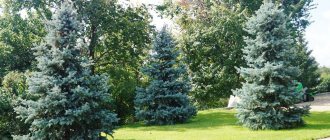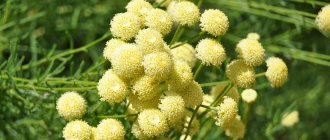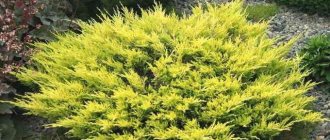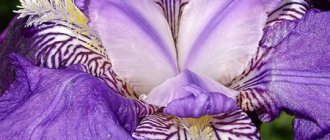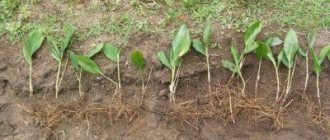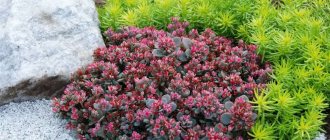Description of Spirea Shirobana
Japanese spirea Genpei Shirobana is a small plant, about 70-80 cm high. The bush is highly branched and quickly grows in width - the diameter of the bush can reach 120 cm. Young branches of spirea are pubescent. The color of the shoots is reddish-brown.
The shape of the leaves is ovoid, slightly elongated. They are small in size. The outer part of the leaf blade is dark green, but the leaves below are bluish. In autumn, green tones turn into orange or even reddish shades, making the spirea bush look beautiful even after flowering has ended.
The color of Shirobana spirea flowers varies from white to soft pink shades. This variety blooms throughout the summer.
Planting and care of Japanese spirea Shirobana
Planting Shirobana spirea, as well as subsequent plant care, as a rule, does not cause much difficulty. What you should pay attention to before planting shrubs:
- Spiraea Shirobana prefers open sunny areas, but also grows well in partial shade.
- There are no special requirements for the composition of the soil, but it is better to plant spirea on loose, light soils.
- The recommended planting time for the Shirobana variety is early September.
- It will be easier for seedlings to adapt to a new location if planting is done in rainy, cloudy weather.
This garden crop is unpretentious and will do little harm if it does not follow these recommendations, however, the listed conditions are necessary for the bush to bloom as abundantly as possible.
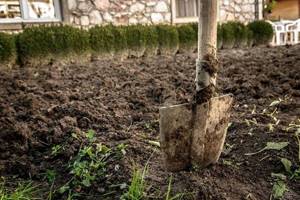
Preparation of planting material and site
Preparing a site for planting Shirobana spirea comes down to digging up the site and adding organic fertilizers to the soil. As for planting material, it does not require any special preparatory procedures. It is enough to inspect the seedlings and reject specimens with significant damage: cuts, broken shoots and ruptured roots.

Planting spirea Shirobana
The planting algorithm for the Shirobana variety is as follows:
- Holes are dug in the area, the diameter of which should be slightly larger than the area of the roots of the seedlings. The depth of the pits should not exceed half a meter.
- At the bottom of the holes I put drainage: pebbles, gravel, broken bricks or clay shards.
- The drainage layer is sprinkled with a mixture of peat, sand and garden soil, taken in equal proportions. It is necessary to pour a thin layer of soil on top of this soil mixture so that the roots of the spirea do not directly touch the peat.
- The seedlings are lowered into the holes, the roots are evenly distributed along the bottom and covered with earth. The root collar should be level with the ground or slightly higher; it cannot be buried.
- Plantings are watered and mulched. Mulch helps to better retain moisture in the tree trunk circle. Peat or walnut shells are best suited as mulch.
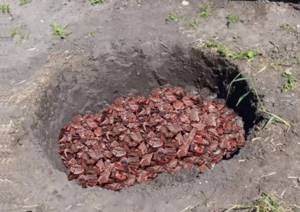
Watering and fertilizing
Spirea Shirobana needs more careful care in the first year of life, which includes frequent watering. The soil near the bush should not dry out. Adult plants are watered at least 2 times a month. At the same time, about 10-15 liters of water are consumed for each bush.
Bushes are usually fed in the spring. Complex fertilizers are applied to the soil according to the instructions. Young seedlings can be fed in the summer with a solution of mullein with the addition of

Trimming
Sanitary pruning of last year's shoots is carried out in early spring. It is important to do this before the buds open. Weak shoots can be removed completely. The procedure promotes more active growth of young shoots.
In the 4th year of life, you can carry out intensive rejuvenating pruning of Shirobana spirea. To do this, the branches are pruned so that only stumps about 30 cm long remain. Starting from the age of 4, such pruning can be carried out annually.
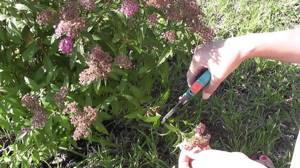
After each pruning, plantings are watered and fertilized abundantly. To do this, you can use a solution of manure or superphosphate. Recommended proportions: 10 g per 10 liters of water. Fertilizer is applied at the very root of the spirea.
Preparing for winter
Spiraea Shirobana is capable of overwintering without any harm to development without covering material, but this only applies to adult plants. Young seedlings are too weak to survive the winter under natural cover - snow. It is recommended to sprinkle them with a thick layer of dry leaves.
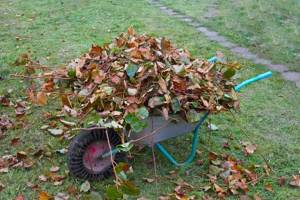
How to plant?
If you follow some subtleties when planting this plant, the bushes will turn out especially lush and beautiful. Moreover, abundant flowering will be observed every year.
Deadlines
Of course, like most plants, spirea can be planted in the spring. However, experienced gardeners believe that it is best to plant shrubs in the fall (in the first weeks of September).
It is during this period that the most suitable weather often occurs: cloudy and a little rainy.
Selecting a location
For bushes, it is recommended to choose areas open to sunlight. Although "Shirobana" grows well in medium shade. There are no strong preferences based on soil. However, to obtain more beautiful flowers, you should choose loose and light soil. It is worth noting that the more nutritious the soil, the larger the shrub will be .
Soil preparation
When preparing a place for planting, you first need to dig up the soil and add organic fertilizers to it. There is no need to specially prepare planting material. Then you should inspect the seedlings and select the strongest and healthiest ones, without damage, especially on the roots. If the root system is too dry, you can put the plant in a container of water for several hours.
Spiraea is planted in pits. Their diameter should slightly exceed the area of the seedling's root system. As for the depth of the hole, it should be about 0.5 meters. The bottom of the recess should be lined with pebbles, gravel, broken bricks or clay shards. Sand, peat and garden soil are poured onto the resulting drainage layer, taken in equal proportions.
Experienced gardeners advise including complex mineral fertilizer in the soil mixture. 1 tablespoon is enough for one plant. This will provide the bush with food for several years.
Planting scheme
When the holes are completely ready, seedlings are lowered into them. In this case, it is important to distribute the root system evenly over the area of the hole. It is necessary to fill it with soil so that the root collar is on the surface of the soil or slightly higher. Upon completion, the planted seedlings are watered and sprinkled with mulch. This is necessary so that as much moisture as possible is retained in the tree trunk circle. Peat and walnut shells can be used as mulch.
When planting, it is important to remember that the root shoots of the plant are quite large and require a significant area.
When more than one bush is planted, you need to leave at least 50 centimeters between it and its neighbors. Between the rows it is necessary to maintain a distance of 70 centimeters.
Reproduction
Spiraea Shirobana can be propagated in the following ways:
The latter method is used very rarely, since during seed propagation there is often a loss of varietal qualities of a garden crop.
The most popular is cuttings from spirea. The advantage of this method is the high survival rate of planting material even without treating the cuttings with growth stimulants.
Shirobana spirea is bred by cuttings as follows:
- The bush is inspected and an annual shoot is selected from it.
- It is cut off almost to the root and the resulting cut is divided again into several parts. The length of the cutting should be on average 15 cm. Each part should have no more than 6 leaves.
- The bottom of the cuttings must be cleared of leaves.
- The remaining leaves are cut in half.
- The cuttings are dipped for 5 hours in a solution of the drug “Epin” (1 ml per 2 liters of water).
- After this time, the lower cut of the cuttings is sprinkled with a growth stimulator (you can use Kornevin), after which the planting material is planted in containers filled with sand.
- The cuttings are buried at an angle of 45°.
- Then the cuttings are covered with jars or film, after which the containers are put into the shade.
- With the onset of the first cold weather, the boxes are dug into the ground and covered with dry leaves.
- In the spring, the boxes are opened and the spirea is transplanted to a permanent place.
Care instructions
Despite its unpretentiousness and frost resistance, care for Japanese spirea is necessary. The plant is not able to tolerate prolonged drought and abundant watering. The first causes the death of the bush, and waterlogging causes the development of fungal diseases. Caring for the plant comes down to periodic watering, weeding and loosening the soil.

Watering
The frequency of watering depends on the selected variety. Summer-flowering plants consume a lot of moisture during the growing season, and spring varieties can tolerate short-term drought.
It is recommended to water the shrub in doses. In waterlogged soil, the root system rots. In dry summers, it is necessary to add up to 15 liters of water for large bushes, and up to one bucket for dwarf bushes.
Top dressing
Japanese spirea is fed twice a season. After spring pruning, it is recommended to apply mineral fertilizers under the bush. In summer, you should feed the crop with mullein solution.
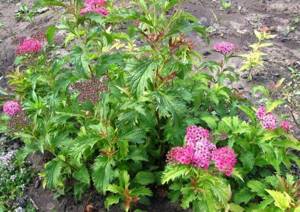
If the plant grows in depleted soils, then the spirea also needs to be fed in early autumn. However, during this period it is prohibited to apply fertilizers containing nitrogen. This feeding stimulates the development of shoots, which is why the plant does not have time to gain enough strength for wintering and dies by next spring.
See also
How to cut petunia in the fall at homeRead
Loosening, mulching
The shrub develops well in loose soil. Such soil provides an influx of oxygen in a volume sufficient for the root system. Therefore, after watering, it is necessary to loosen the soil, removing weeds.
After planting, as well as during the warm season, it is recommended to apply a layer of mulch 5-8 centimeters thick under the bush. This reduces the rate of moisture evaporation. Gardeners use peat or dry compost as mulch.
Drafts
Japanese spirea is not afraid of drafts. Therefore, shrubs can be planted in open spaces. But due to strong gusts of wind, the process of bud formation is disrupted.
Pruning, replanting
Japanese spirea is distinguished by its rapid development. To avoid the growth of the crop, it is recommended to prune new shoots to the first buds with the onset of spring. Also, after winter it is necessary to remove damaged and dead branches. This procedure will ensure normal plant growth. Infected pruning must be burned.

4-year-old spireas require removal of excess length - up to 30 centimeters of each branch. This procedure allows you to achieve a more luxuriant crown and increase the number of flowers.
You can replant an adult shrub in the fall. The plant should be dug up based on the volume of the crown. The root system usually does not grow further than the shoots extend. It is necessary to move the bush to a new place together with the turf soil. Soil from the old site will speed up adaptation.
Diseases and pests
Spiraea Shirobana rarely gets sick, but plantings can be affected by pests. The most dangerous insects for this variety include the following insects:
- aphid;
- spider mite;
- rose leaf roller.
The fact that the spirea has been infected by a mite is indicated by the formation of a thin web on the leaves. In addition, the bush begins to turn yellow ahead of schedule. Soon after this it drops its leaves.
The danger of spider mites is that they very quickly deplete the bush. You can’t drag out the fight against him. Any insecticide can effectively control pests, but the drugs “Phosfamide” and “Karbofos” have proven themselves especially well. The dosage is indicated in the instructions.
Aphids plague gardeners in the second half of summer. The presence of the pest is determined by the inflorescences eaten, from which the insect sucks out the juice. It also affects the leaves, on which small holes appear. You can get rid of aphids using the Pirimor insecticide, a solution of grated laundry soap or ash.

Features of planting and care, photos of varieties of magnificent Japanese spirea
For all its external beauty, Japanese spirea is easy to plant and care for. The peculiarity of this plant is that it is very hardy and can easily adapt to various natural conditions. In our country it is grown almost everywhere, from the South coast to cold and dry areas. However, there are several varieties that can freeze in harsh winter conditions; they require spring pruning for sanitary purposes, after which the bush will recover and bloom in the same year.
Japanese spirea needs 3-4 hours of direct sun during the day; if this minimum is met, the owner of the plant will be able to admire not only lush growth, but also abundant flowering. In constant sunlight, the bush will naturally be even more luxurious.
Growing a plant
Planting in open ground is recommended in spring or autumn. Moreover, the last period is recommended for all varieties of Japanese spirea, and the first - only for late flowering ones, before the buds swell. If replanting is carried out in the spring, then it is necessary to wait until the soil warms up completely.
Preparation of seedlings
When preparing Japanese spirea for planting, it is recommended to follow a number of rules:
- purchase seedlings with a root system covered with soil;
- refuse to buy a plant with blossoming leaves;
- buy seedlings with light green bark, without visible damage;
- Before planting, cut the roots to 30 centimeters and soak the plant.
A properly prepared plant takes root more successfully in a new location. If necessary, before planting, the roots are treated with a growth stimulator. But this procedure is not mandatory.
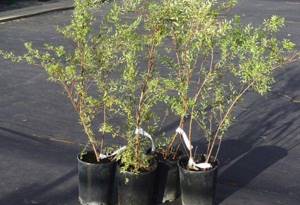
Site selection
Japanese spirea is recommended to be planted in well-lit areas. Due to lack of sunlight, the shrub will not bloom. The root system of the crop is characterized by active growth. Therefore, the shrub should be planted at a distance from other plants. The distance between neighboring spirea should exceed 50 centimeters.
Soil requirements
Japanese spirea can grow in various soils. But gardeners recommend growing the crop in mixed soils (leaf or turf). When preparing a site for planting seedlings, a drainage layer, turf soil, humus, peat with low or neutral acidity and river sand should be added to the dug hole. It is also worth adding fertilizer intended for leaf crops as a top dressing. Thanks to this soil mixture, growing ornamental shrubs is simplified.

Planting
It is necessary to plant Japanese spirea according to the following algorithm:
- Dig a hole. The diameter of the hole is selected taking into account the volume of the root system, and the depth should be 40-50 centimeters.
- Pour the prepared soil mixture into the hole and form a small hill at the bottom of the hole.
- Place a seedling on a hill in the center and straighten the roots.
- Cover the seedling with soil so that the root collar remains flush with the ground.
After planting, the bush is watered abundantly. There is no need to apply mineral or other fertilizers during this period.
Agrotechnical features of growing Japanese spirea
Photos of Japanese spirea can often be found not only on the Internet, but also on the pages of monthly catalogs with planting material, where many different varieties are offered to gardeners. Flowering begins in July and continues until August. Only those shoots that appeared on the plant this year flourish. Seed ripening period is October. Daughter plants take root easily. For successful rooting, you need to dig a hole the size of which will correspond to the roots. If the soil is fertile, then planting will not require additional fertilizing with fertilizers. This shrub is often used as a hedge; for example, the Japanese spirea variety “Goldflame” is suitable for this purpose.
Where is the culture used?
Spiraea Shirobana is actively used for group plantings and as hedges. Dwarf varieties are excellent for rockeries, living carpets, and rocky gardens.
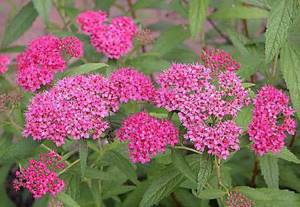
But as a single plant, spirea looks very beautiful in areas.
There are many varieties of the crop that have different flowering periods. The popularity of the plant is associated not only with the beauty of its flowers, but also with its unpretentiousness. In addition, spirea seedlings are inexpensive, which means everyone can buy them for themselves. Having your own plant on the site, in the future you can easily grow seedlings yourself. Spiraea Shirobana is good for landscape design. From plants you can create decorative borders and entire compositions that will decorate your garden plot. Spiraea is an excellent material for cutting; the plant can be given a variety of shapes. But, unfortunately, it will not bloom. In general, Shirobana spirea is a universal plant that can decorate a summer cottage.
Decorating a personal plot using Japanese spirea plantings

The shrub looks bright all year round, so it is very convenient for decorating gardens. There are no so-called “dips” in its beauty that affect a particular season. The roots of the plant do not entwine the roots of its neighbors, and the bush itself is not distinguished by a large number of root shoots. The plant gets along well with any environment.
Recommendation: Japanese spirea variety “Krisla” can be used to create a shrub-woody group, in which its purpose will be to camouflage the open trunks of tall-growing representatives.
Such as: mock orange, lilac, magnolia. The compactness of the bush allows it to be planted even in flower beds with bulbous plants and annuals. They can also be used to decorate rock gardens with low-growing perennials. Spiraea is indispensable where it is necessary to create a single bright image, for example, as a hedge, dividing border, when planting slopes.
Spirea plantings need to be trimmed once a month, but the plant, of course, will not bloom. Therefore, before planting, it is advisable to decide in what capacity this shrub will be used, as a profusely flowering plant or as a decorative foliage form. It lends itself perfectly to pruning, the bush is completely leafy and well developed. Some compact plants produce wonderful golden foliage, such as the Japanese spirea variety 'Goldmound'.
Sanitary or anti-aging pruning is carried out so as not to disturb the symmetry of the shoots. Only broken branches and dead wood are cut out. Bushes that are more than 4 years old undergo more detailed pruning; several branches are removed from them down to the base of the trunk.
Planting spirea
Landing location
The area for these shrubs must be located in a sunny place, even in hot southern regions.
Boarding time
The best time to plant spirea is September. Favorable weather is cloudy, or even better – rainy, when the soil is well saturated with moisture.
Soil and size of planting holes
Spiraea grows and develops best on loose, breathable soils with a lot of humus. Of course, plants will grow on poor soils, but in this case they will not be able to show all their beauty.
The size of the landing holes is determined as follows:
- If the soil on your site is exactly what spirea likes, the planting holes should be 25-30% larger than its root system and 40-50 cm deep.
- If the soil at the site for growing is not entirely suitable, then it is advisable to dig a hole three times larger than the root system of the seedling. Both in width and in depth.
The mixture with which the hole will be filled is made up of sand (river), peat and turf or leaf soil. Moreover, two parts of earth are taken, but sand and peat are taken in one part.
The distance between planting holes depends on the placement of spireas and flowering time:
- Summer-flowering spirea, when planted in a hedge, is planted at a distance of 40-50 cm from each other; when arranged in several rows, the distance between rows is 30-40 cm. In group plantings, a distance of 50-70 cm is maintained, sometimes up to 1 m.
- Spring-flowering spireas are planted more freely. In hedges at a distance of 70 cm - 1 m, in group plantings - 1-1.5 m. For group planting, holes are dug at a distance of 50-70 cm.
Landing technology
Before planting, soil is first poured into the bottom of the hole, and then the seedling is installed, all the roots are straightened out and only then everything is carefully covered with an earthen mixture.
The bush is planted so that the root collar (the junction of the trunk and roots) is located at ground level.
Before planting, the root system must be inspected and broken and dried roots must be cut off.
If you plant a seedling with a lump of earth, then after planting, carry out good watering.
And if the root system is bare (without soil), then it is placed for 12 or 24 hours in a solution of water and a root formation stimulator. This can be heteroauxin, succinic acid, indolylacetic acid and various other drugs that can be purchased at any garden or flower center. Plants treated in this way are immediately planted in their permanent growing location.
Read also: Scheme for planting strawberries in spring in open ground with black spunbond
We also need to remind you of one nuance that should be taken into account when preparing the hole for planting. Although spirea love moisture, there should be no water (underground or after rain) near their roots under any circumstances. Therefore, if planting is done in the ground with a large amount of clay, then drainage must be poured into a hole (dug 2-3 times larger than the root system of the bush). For this, gravel or crushed stone is usually used. The height of the layer should be 10 -15 centimeters. Then soil is poured over the drainage, into which young spirea is planted.
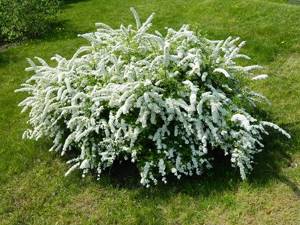
Decorative varieties of Japanese spirea: features and disadvantages
Japanese spirea, as the name suggests, was brought to us from Japan, but it is also grown in China. A beautiful shrub with tomentose-pubescent shoots, oblong succulent leaves, green at the top and bluish below, which by autumn are colored in various shades of red-orange. Flowering continues up to 50 days a year. This type of spirea has many varieties that differ in the intensity of color and flowering, height, and crown shape. In our country, the following varieties are considered the most common.
General characteristics and description of the plant
Japanese spirea, or Japanese meadowsweet (lat. Spiraea japonica) is a perennial deciduous shrub or shrub belonging to the Rosaceae family. The shoots are erect, with thick felt pubescence; in young shoots the pubescence is soft and appressed. The leaves are simple, petiolate, pubescent. It is highly valued for its flowers - panicles or corymbs collected in inflorescences .
The peculiarity of this plant is that it is very hardy and can easily adapt to various natural conditions.
Depending on the variety, the flowers can be white, red, pink, etc. Also, depending on the variety, flowers can be located both at the top of the stems and along almost the entire length of the shoot.
Japanese varietal spirea is usually divided into summer-flowering and spring-flowering.
Varieties of Japanese spirea
Japanese spirea has about 100 species and hybrids. The most popular are:
Little Princess
Forms a small shrub about half a meter high. Prized for its vibrant foliage and panicles of soft pink flowers. Blooms in mid-summer . Well suited both for single planting and for decorating hedges, alpine slides, and flower beds.
Golden Princess
It is a shrub and reaches a height of up to 80-100 cm and has a spread of almost a meter. It got its name for the golden color of the foliage, which appears closer to flowering. The flowers are large, dark pink, well shaded by leaves.
Shirobana
It is a summer bloomer. Tall shrub reaching up to a meter. It differs from others in its narrow elongated dark green leaves. The colors of the flowers range from white to almost red . It needs pruning, since the crown is formed very chaotically during the growth process. The variety is notable for the fact that it often produces inflorescences shaped like a heart.
Albiflora
Distinguished by white flowers. A low shrub or shrub that blooms in late summer . It has a strongly growing crown and needs regular pruning and removal of faded flower stalks.
Goldflame
They love it for its rapid growth and powerful flowering. One of the most powerful varieties of Japanese spirea. Reaches a height of up to 1 meter . Over the course of the season, the foliage changes color from orange in the spring and bright yellow in the summer to copper in the fall. The flowers are bright pink, clearly visible against the contrasting foliage. The variety takes root very well in urban environments.
Japanese spirea in landscape design
Due to its high decorativeness, unpretentiousness and frost resistance, it is used in many garden plots. In spirea, both flowers and leaves are decorative, since many varieties change their color depending on the season. We can safely say that this type of shrub is one of the most popular among landscape designers. It is used in the design of hedges, alpine slides, for the design of artificial ponds, and in flower beds . Looks good as a single shrub. It successfully tolerates proximity to most other ornamental plants.
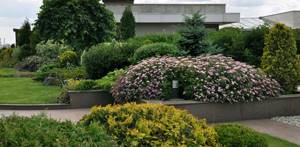
Using Japanese spirea in garden design
Spiraea does not cause problems in care, is unpretentious, and resistant to cold. It grows quickly and provides a large area of coverage. Even a novice gardener can handle pruning and fertilizing, and in return the plant will delight the eye with its bright leaves and fragrant flowers from the first warm days until the leaves fall.
Landing
The most optimal time for planting spirea is autumn after leaf fall. Less commonly, spirea is planted in early spring, immediately after the snow melts before the first buds bloom. The plant is not demanding on soil, but is light-loving . Some varieties are more shade-loving, and the planting location is based on the characteristics of the variety itself.
Too long, unhealthy, damaged roots of the seedling are cut off. The branches are shortened by an average of a third, diseased and damaged branches are cut off at the root.
Care and cultivation
Spiraea is loved for its unpretentiousness, resistance to frost and disease, and its proximity to other ornamental plants. However, almost all varieties have certain maintenance requirements. Due to the characteristics of the root system, spirea does not tolerate drought well and requires regular weeding and loosening to improve oxygen access to the roots. Some varieties require regular crown formation to ensure a neat appearance of the bush.
Watering
The weak root system of spirea requires regular watering, especially during dry seasons. Spring varieties are more tolerant of lack of moisture , while summer varieties, especially during flowering, absorb large amounts of water.
Spiraea should be watered sparingly
During drought, each bush is watered with 1.5 buckets of water once every two weeks. The plant needs good watering in the spring after planting and after pruning to restore vitality.
Top dressing
On fertile soil, spirea does not need additional feeding. It is allowed to feed the plant with peat or compost once a season in the fall or spring after the snow melts. Spiraea must be fed with mineral fertilizers immediately after planting .
In order for spirea to delight you with lush and long flowering, it is useful to pamper it with liquid fertilizers twice during the summer.
During growth on nutrient-poor soils, fertilizing is carried out in the spring before flowering, after flowering and after pruning, as well as in the fall. In mid-summer, the plant can be fed with a solution of mullein with the addition of superphosphate.
Trimming
Pruning is an important point in spirea care. Bushes tend to grow and become overgrown. Pruning is carried out to form the crown, to rejuvenate the shoots, and to improve the health of the bush as a whole.
The more you prune the plant, the more powerful and luxuriant the bush will grow.
Preventative pruning is carried out before buds begin to open . Frozen tops are trimmed, dried and diseased trunks are trimmed. Bush rejuvenation is carried out when the plant begins to age and produce fewer flowers. The entire bush is completely cut off at the root in the fall. In the spring, young shoots will emerge from the roots.
Spring varieties are pruned immediately after flowering, summer varieties - in the spring of next year. During flowering, drying flower stalks are cut off so as not to waste the vitality of the plant.
Care
Regular and proper care of spirea is the key to its beautiful appearance, freshness and lush flowering. The plant is a moisture-loving plant, so it requires regular watering. The lack of the required amount of water has a detrimental effect on the growth rate of the shrub and on the quality of its flowering. In hot, dry weather, the crop needs to be moistened every two weeks, using at least 10 liters of water per plant.
Learn about the features of growing spirea of the Little Princess variety.
Mandatory spirea care procedures include loosening and weeding the soil. The first activity is carried out after each moistening, going deep into the soil up to 6 cm. Loosening allows you to enrich the soil with oxygen and minerals, thereby accelerating the growth of the root system. As the weeds grow, they are weeded. It is especially important to remove all weeds before they begin to bloom.
Despite the fact that Jenpei is characterized by excellent frost resistance, it does not hurt to cover it for the winter with agrofibre or any breathable, breathable material, after carefully bending the branches to the soil.

Reproduction
The plant can be propagated by dividing and replanting the old bush, as well as using seeds, cuttings and layering.
Seeds
Only non-hybrid species can be propagated by seeds, since the seeds do not retain the varietal qualities of the parent plant. Seeds are sown in spring in boxes with fertile soil, previously well moistened. The seedlings are planted in open ground after 3 months .
Cuttings
Cuttings can be carried out starting from the third decade of June. The shoot is cut into several equal parts, which are planted in a mixture of peat and river sand. Cuttings require high soil and air humidity - watering is done up to four times a day, spraying up to eight. In winter, the cuttings are covered, and in the spring they are planted in a new place.
Dividing the bush
Dividing the bush is carried out only in young plants no older than three years. Old plants will not tolerate transplantation well and will not produce good shoots. Division is carried out in the fall after leaf fall or in the spring before the first buds bloom . The bush is dug up and divided into several daughter plants. One daughter bush must have at least five mother trunks. Next, the daughter bushes are transplanted to a new location.
By layering
One of the most effective methods of propagation is propagation by layering - such seedlings have a fairly high survival rate. The vegetative branch is not cut from the main bush, but is pressed to the ground with staples and covered with soil or a peat-soil mixture. The branches take root well, and the daughter seedlings can be transplanted to a new location without much difficulty.
Growing conditions
Let's find out what requirements the Japanese spirea makes for the conditions of its maintenance and location.
Selecting a location
Although the plant is unpretentious, it will best demonstrate its decorative qualities when planted in a sunny, well-lit area. By the way, spirea can feel quite good in the shady corners of the garden, however, in this case it will not be particularly decorative: the inflorescences will be smaller and the color of the foliage will not be so bright.
It is also important to know that the space allocated for spirea must be quite large, since the roots of the plant grow underground over an area larger than the area of the shrub itself.
Japanese spirea will feel best in fertile, well-fertilized soil. Take care of this before planting by adding the necessary nutrients to the soil.
Planting time and seedling selection
Spiraea should be planted in open ground in the spring. However, it is necessary to have time to plant before the leaves bloom on the plant. Purchase seedlings from trusted nurseries, paying attention to the roots of the plant: it is important that they are not overdried. Otherwise, the spirea will not take root. When purchasing seedlings with bare roots, choose specimens with live buds, but not yet starting to grow. Bend the roots and shoots (without fanaticism) - they should be flexible and not brittle.
Preparing for landing
If the plant has damaged roots, remove them with sharp, well-disinfected pruners. If some healthy roots are too long, shorten them too.
Before planting, soak the roots of the plant in water with potassium permanganate. The procedure will simultaneously solve two problems: it will relieve the roots from drying out and ensure disinfection.

How to properly plant Japanese spirea in open ground.
The first step is to prepare the hole. Its volume should be one third greater than the approximate volume of spirea roots. The hole should be allowed to settle for two to four days before planting.
Planting should be done in cloudy weather or rain. Place a drainage layer of crushed brick at the bottom of the dug hole with a layer of approximately 15-20 cm. The soil should be as follows:
- turf soil - 30 parts;
- humus - 2 parts;
- peat soil - 1 part;
- river sand - 1 part.
Mix all ingredients.
Dip the roots of the plant into the hole, straighten them carefully, and cover them with carefully prepared soil mixture. The root collar should be located above the ground and not buried. When filling the hole with soil, immediately compact the soil as the process progresses.
After planting, water the bush using 1-2 buckets of water. Mulch the root circle with dry peat. Also make several depressions in the diameter of the root circle to retain water: in this way you will ensure better hydration of the plant's roots.
A couple of days after planting, water the plant with water with ammonia dissolved in it. This substance acts on spirea like an anti-stress drug: it will nourish the roots while they have not yet completely taken root. In addition, ammonia will help you gain green mass faster. By the way, fertilizing with ammonia can be done later, when the plant has already taken root and is actively growing.
Below is a description of the main points for caring for Japanese spirea growing in open ground.
To ensure long-term and abundant flowering of spirea, you should pamper it with additional nutrition. Proper care involves fertilizing twice a season: after spring pruning and in July. In the spring, add a mineral complex solution, and in the summer, add a mullein solution. It is recommended to pour from 1 to three liters of fertilizer under one bush.
Loosening, mulching
Japanese spirea grows best in loose, well-permeable soil. Therefore, after watering and rain, it is advisable to loosen the soil in the root circle, removing weeds at the same time. Mulching will help retain moisture and get rid of weeds. Use dry compost or peat as mulch.
Japanese spirea is not afraid of the wind, so it can feel good in open areas. However, too strong gusts can negatively affect flowering, so it is better to protect the spirea from drafts during the period of bud formation
The plant needs moderate watering. If it is hot outside, then the moisturizing procedure is mandatory. On average, in cool weather they spend 10 liters of water (a bucket) per bush with one watering, in hot weather - 20 liters. Watering frequency - twice a month.
Irrigation and spraying
As for spraying, spirea does not need this procedure. Irrigation is beneficial for its root system; there is no need to irrigate the foliage.
Pest treatment
In general, this plant is resistant to diseases and pest damage. Nevertheless, although rarely, sometimes spirea is attacked by aphids and spider mites. To cope with these pests, gardeners recommend spraying with a solution of hot pepper, karbofos, and tobacco. Products such as Actellik and Aktara have proven themselves well against spider mites.
Read also: Thuja danica planting and care in open ground leaves turn yellow
But it’s better to prevent pest damage in the first place. Carry out preventive spraying in advance - and then the spirea will always be healthy and strong. By the way, watering with water with ammonia serves not only as fertilizing, but also prevents many plant diseases.
Pruning, replanting
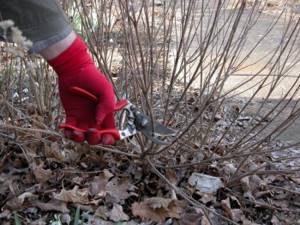
This shrub grows quickly, so regular shaping is necessary. Every year in the spring before the growing season, shorten the regrown shoots down to the first strong and strong buds. In addition, after each winter, remove weed shoots: weak, diseased, frostbitten.
When the bush is four years old, you can prune it further, removing up to 30 cm of shoots. Keep in mind, the more you shorten the spirea shoots, the more lush and profusely flowering the bush will be.
Reproduction

The plant can be propagated in four ways:
In amateur gardening, the method of cuttings or layering is usually used. Dividing a bush already requires a more professional approach, not to mention seed propagation - long and painstaking. In addition, there is a risk of buying the wrong seeds: for example, hybrid varieties of spirea, in principle, cannot be bred from seeds.
Care at different times of the year, wintering
In spring and autumn, the plant only needs pruning, but spirea tolerates winter quite well. However, if you live in an area with snowless and frosty winters, it is better to cover the roots of the plant for the winter. And even if you live in an area with a temperate climate, it is advisable to cover the roots of those plants that are not yet four years old for the winter. Young spirea tolerates cold worse. You can use spruce branches or fallen leaves as cover - a layer of 15-20 cm is enough.
Pests and diseases
In general, spirea is resistant to various pests and diseases. The most unpleasant and dangerous thing for spirea is considered to be the spider mite , whose eggs are quite resistant to most chemicals. Treatment against spider mites is carried out several times to completely destroy all possible eggs and individuals.
The plant is affected by spider mites
In summer, ants can drag aphids onto bushes, especially if the anthill is located close to the bushes. Aphids eat the inflorescences and suck out the juice, causing the plant to lose its attractiveness and become withered in appearance. Another similar pest is the roseate leaf roller.



